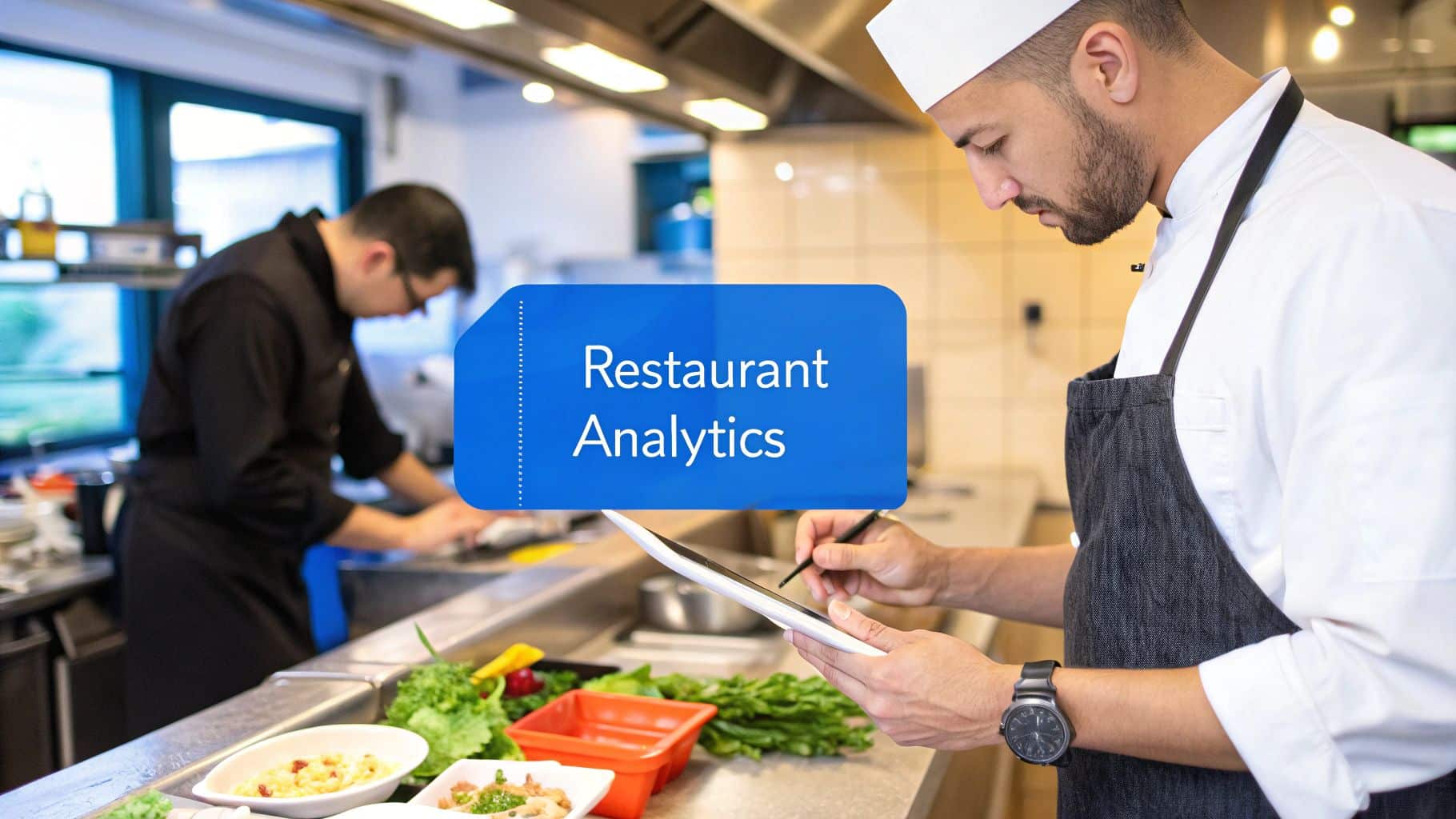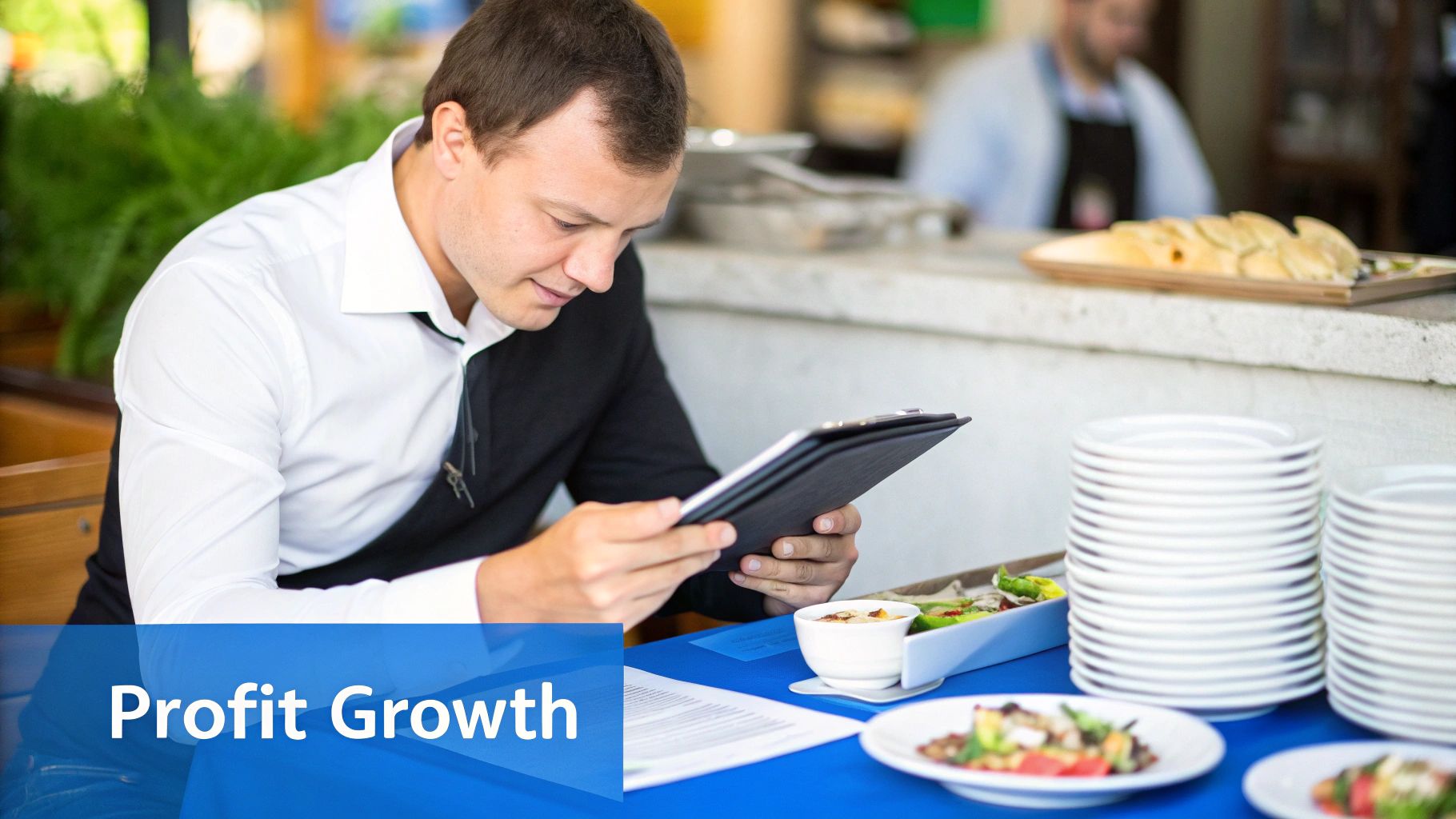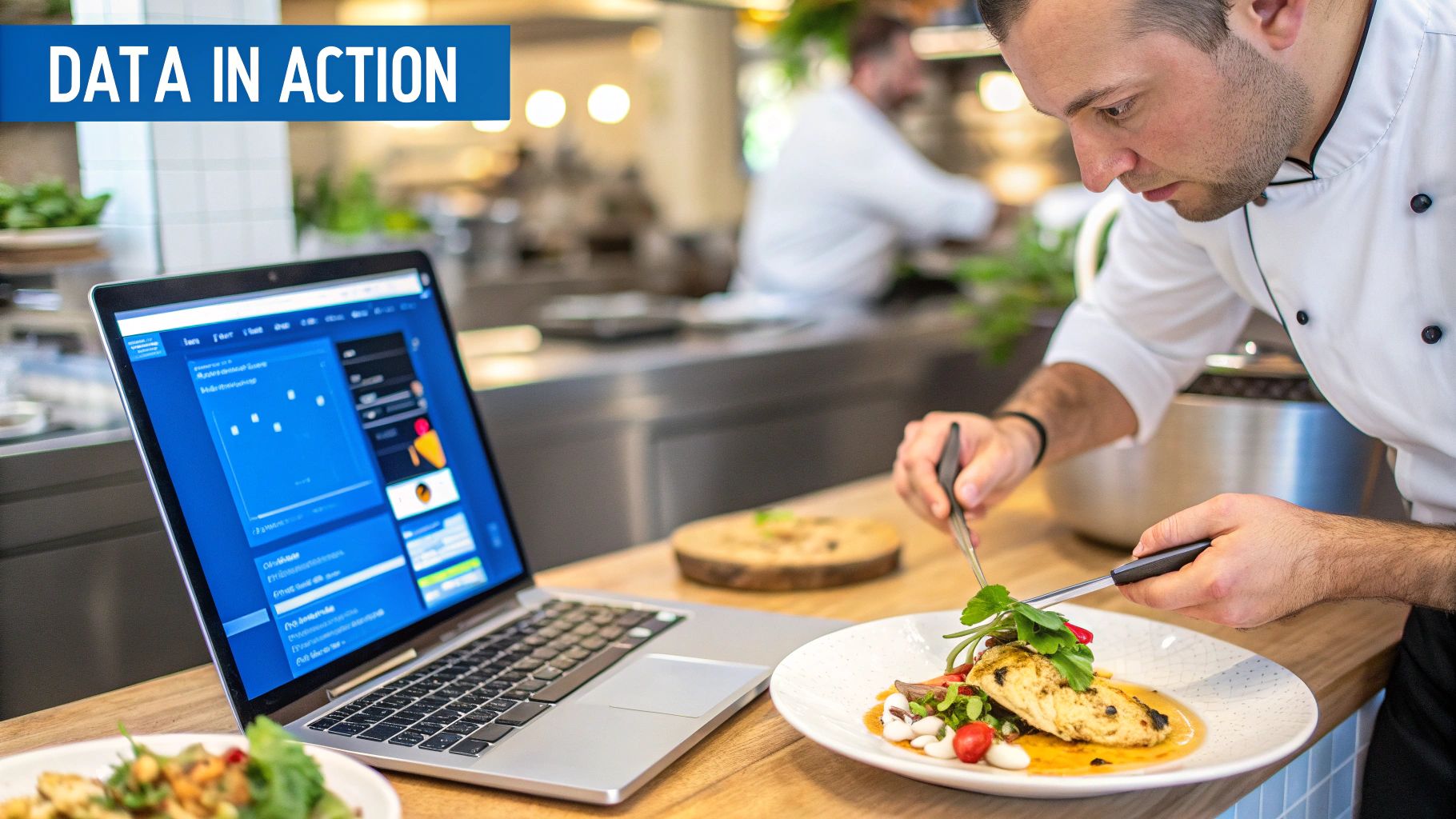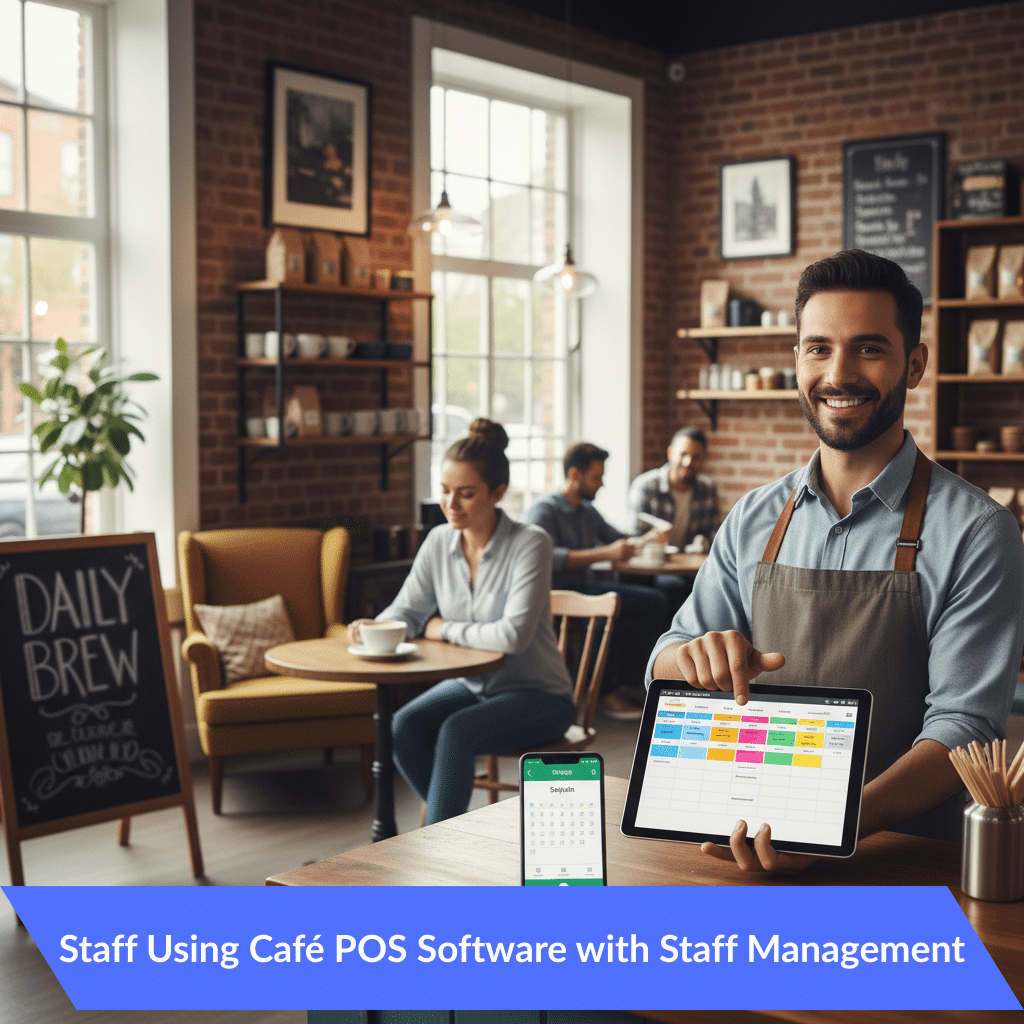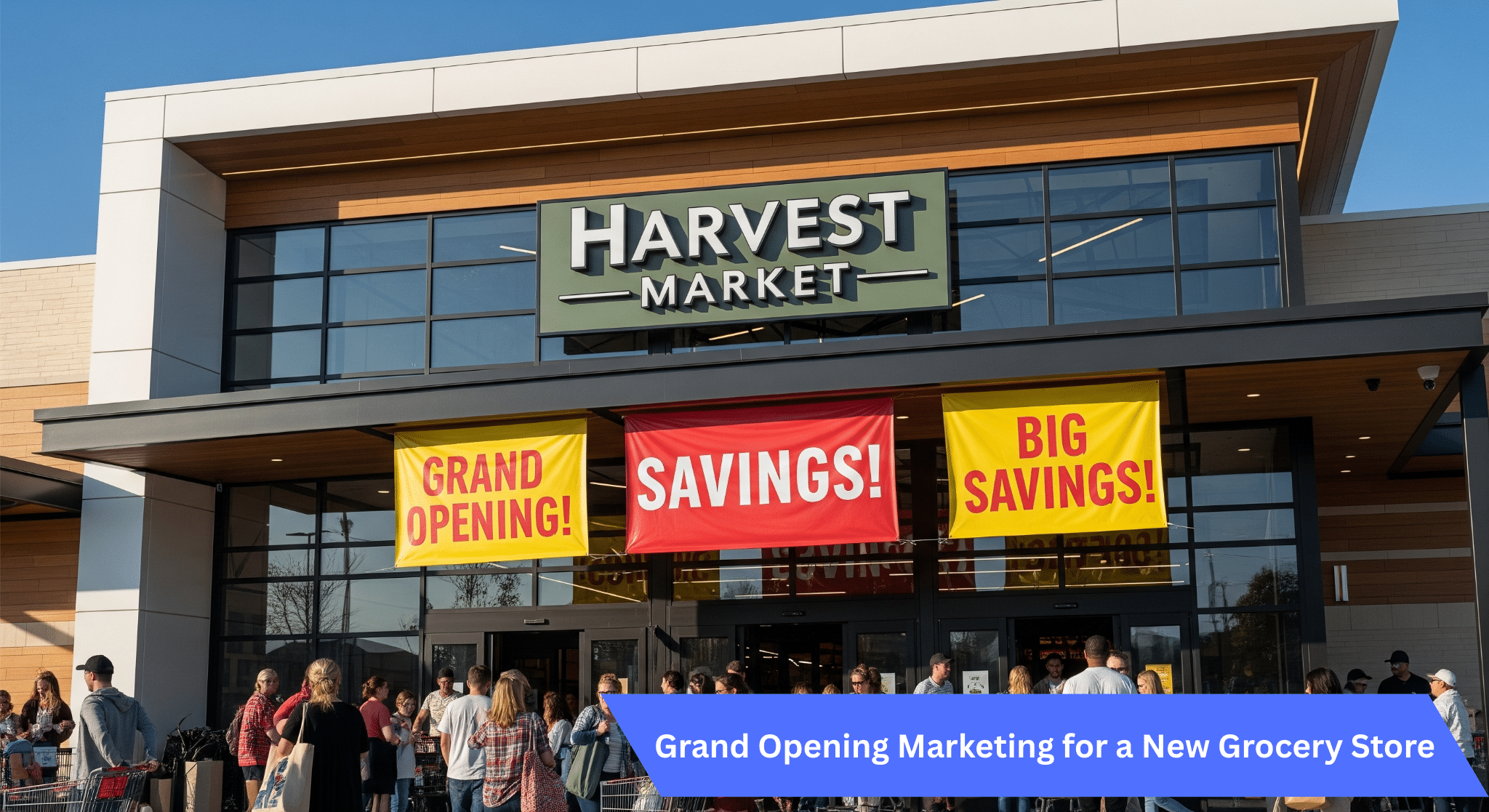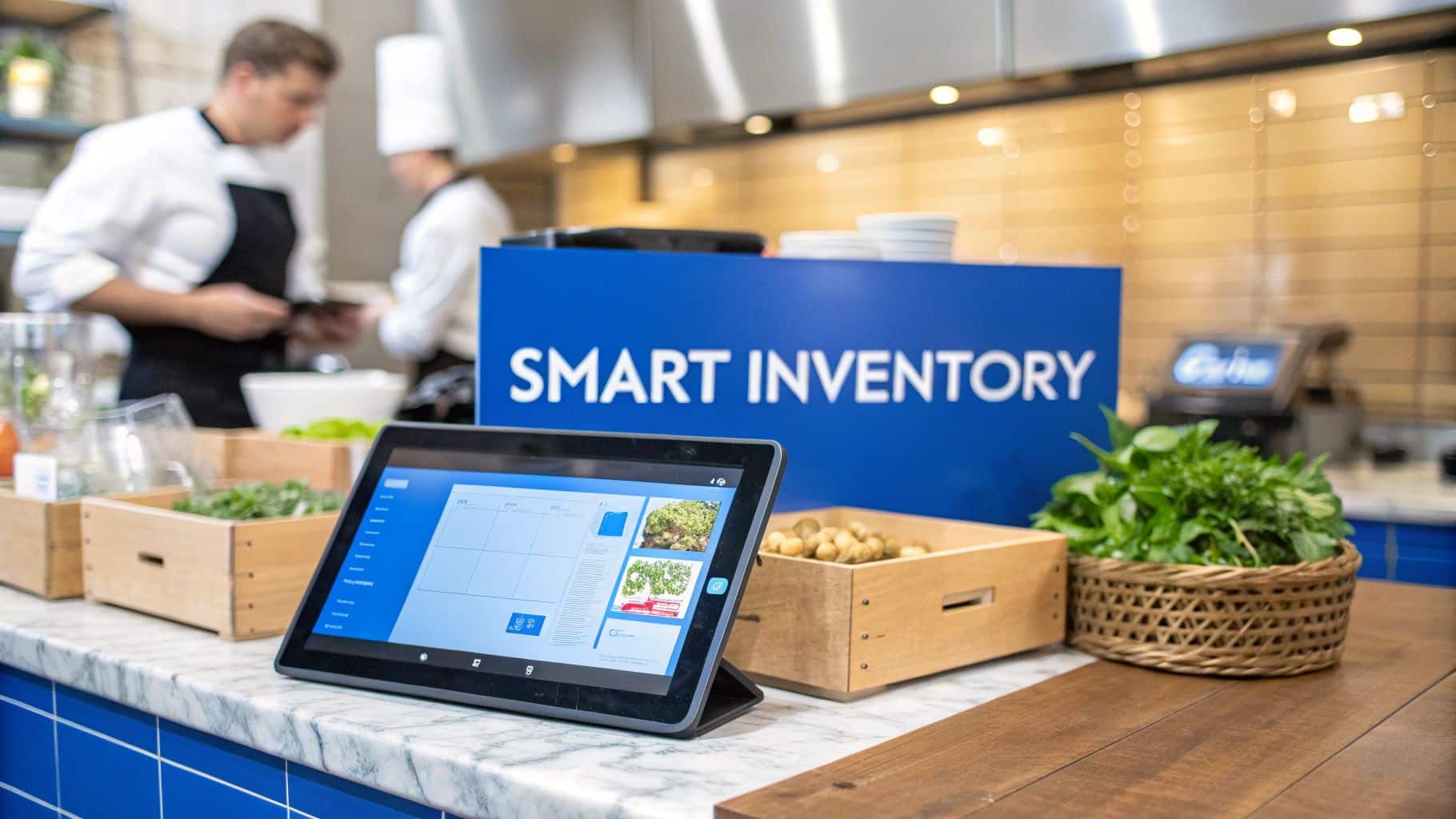Think of all the data your restaurant generates every single day. Sales tickets, inventory counts, employee hours, customer reviews—it's a mountain of information. Restaurant analytics software is the tool that digs through that mountain, finds the gold, and hands it to you on a platter.
It pulls together all those scattered pieces of information and turns them into insights you can actually use to make smarter decisions and grow your business.
What Exactly Is Restaurant Analytics Software?
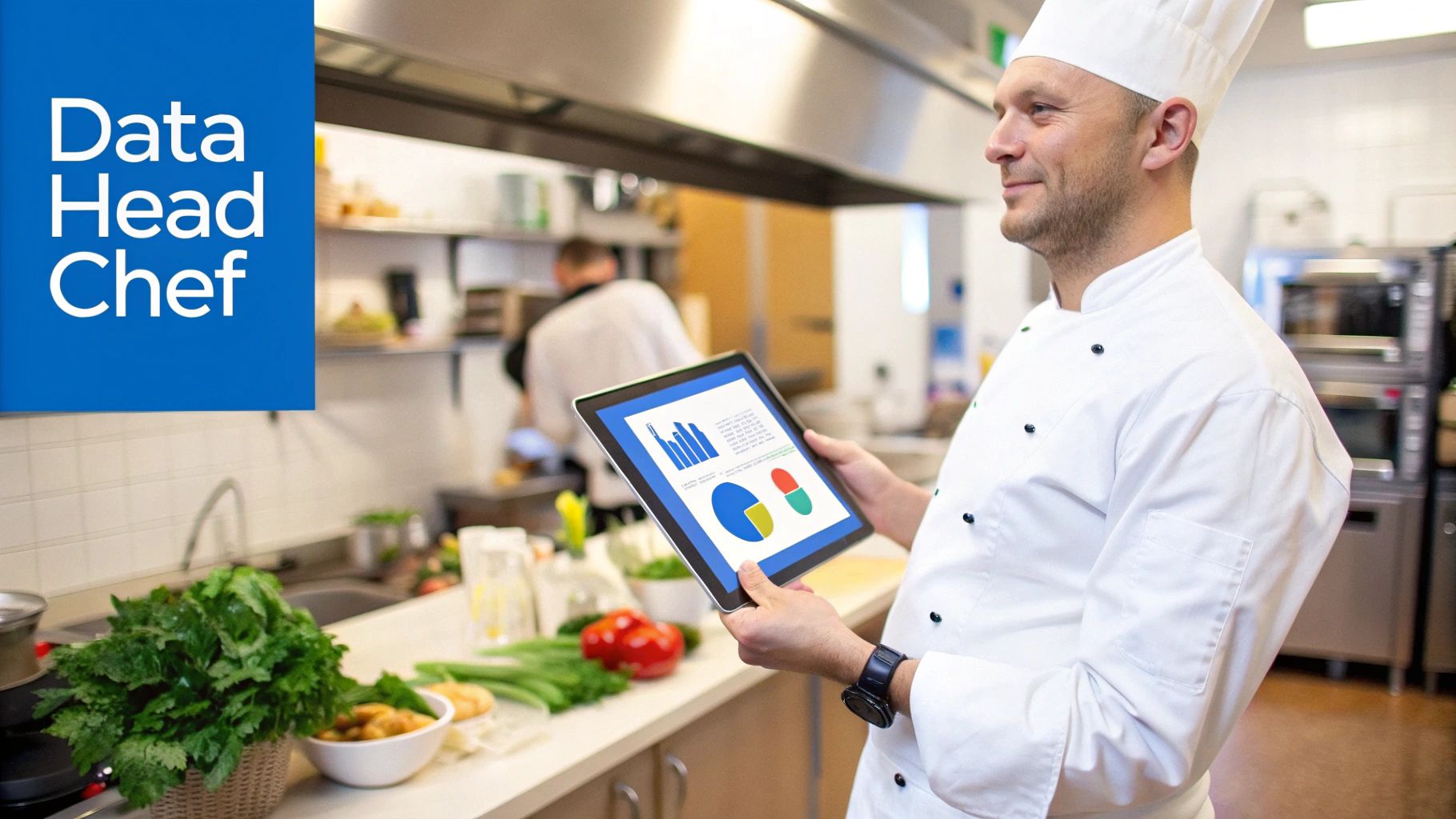
Running a restaurant on gut feelings alone is like trying to cook a complex dish without a recipe. You might get it right sometimes, but it’s mostly guesswork, and one wrong move can ruin the whole thing. You're essentially flying blind.
Restaurant analytics software is what takes the blindfold off. It acts as the central brain for your operation, connecting all your systems—your POS, inventory, scheduling, and even customer feedback platforms—to tell you the story behind the numbers. It’s less about raw data and more about what that data means for your bottom line.
Connecting Dots You Didn't Know Existed
The real magic happens when the software starts linking information from different parts of your business. It goes way beyond a simple sales report from your POS system. Instead, it weaves everything together to show you the bigger picture.
For instance, you might discover that a certain steak dish sells like crazy whenever a specific server is on shift. Why? Turns out, they're a master at upselling it. Or maybe you learn that your lunch specials are most popular on rainy Wednesdays. These aren't just fun facts; they're valuable insights that let you fine-tune your menu, scheduling, and marketing with real precision.
A common misconception is that analytics is only for large chains with dedicated data teams. In reality, modern platforms are designed for the independent owner who wears multiple hats and needs clear, immediate answers without having to sift through complex spreadsheets.
From Raw Data to Actionable Strategy
Ultimately, the goal of this software is to turn information into action. It doesn't just tell you what happened; it helps you understand why it happened so you can make confident, proactive decisions. Instead of guessing, you're building a strategy on solid ground.
Here’s a simple breakdown of how it works:
- Data Collection: The software automatically gathers information from your various systems, doing the heavy lifting for you.
- Data Analysis: It then crunches the numbers, spotting trends, patterns, and outliers that you'd likely miss otherwise.
- Insight Generation: Finally, it serves up these findings in easy-to-read dashboards and reports, highlighting your biggest opportunities for improvement.
This creates a powerful feedback loop where every shift provides new insights to make the next one even better. In today's competitive market, this kind of intelligence isn't just a nice-to-have—it's essential for anyone serious about running a successful restaurant.
Why Your Restaurant Needs to Make Data-Driven Decisions
Let's move past the theory. The real power of restaurant analytics software shows up directly on your bottom line. Making decisions based on data isn't just a fancy trend; it's about turning hard numbers into real profits and building a more robust, resilient business. You're essentially swapping guesswork for a strategic, informed approach.
The industry is catching on, and fast. The global restaurant analytics market was valued at around USD 2.4 billion in 2023 and is expected to hit USD 6.7 billion by 2033. That explosive growth tells us one thing: data is no longer a "nice-to-have" but a core ingredient for success.
Engineer a More Profitable Menu
Your menu is the heart of your restaurant, but let's be honest—not every dish is a winner. Menu engineering reports dig into your sales data and food costs to sort every item, giving you a clear playbook for boosting profitability.
It's helpful to think of your menu in four distinct categories:
- Stars: These are your rockstars—wildly popular and highly profitable. Analytics confirms which dishes are your champions so you can feature them, train staff to upsell them, and keep them in the spotlight.
- Plowhorses: Everyone loves them, but their profit margins are thin. This is where data helps you get surgical. Can you tweak a recipe to lower food costs or make a small price bump without scaring customers away?
- Puzzles: High profit, low popularity. These are your hidden gems. Data prompts you to ask why they aren't selling. Is it a confusing menu description? The price? Its position on the page? A small change could turn a puzzle into a star.
- Dogs: Low profit and unpopular. These items are tying up capital, taking up space in the walk-in, and complicating kitchen operations. Data gives you the confidence to cut them from the menu for good.
By analyzing this information, you stop guessing what your customers love and start knowing. It’s a strategic shift that ensures your menu is designed for peak financial performance.
Slash Food Waste with Predictive Inventory
Food costs are relentless, and every bit of waste is profit thrown in the trash. Predictive inventory analytics is like having a crystal ball for your stockroom, using historical sales data to forecast precisely what you’ll need and when.
Instead of just reordering what you used last week, the software might see a sunny weekend forecast and predict a run on patio seating—and by extension, iced tea and salads. This intelligence helps you order smart, ensuring you don't run out of a bestseller during a dinner rush or end the night with pounds of wilting produce. By aligning your purchasing with actual, predicted demand, restaurants can trim food waste by as much as 10%.
Want to learn more? Check out our guide on how to maximize efficiency and profit with restaurant data analytics tools.
Data helps you find the perfect balance in your stockroom. It ensures you have enough to delight every customer without the financial sting of spoilage, turning inventory management from a guessing game into a precise science.
Optimize Labor Costs for Peak Performance
Right up there with food costs, labor is one of your biggest expenses. Schedule too many people on a slow Tuesday, and you're just burning cash. But get caught understaffed during a Saturday night rush, and you’re sacrificing service quality and losing sales.
Analytics software takes the guesswork out of scheduling by overlaying sales forecasts with staffing levels. It can pinpoint your busiest times—down to 15-minute increments—so you can build a schedule that perfectly matches customer traffic. This means you always have the right number of hands on deck to give great service without bleeding your payroll dry.
What to Look for in Modern Analytics Platforms
Choosing the right restaurant analytics software can feel overwhelming, like staring at a fully stocked pantry and not knowing where to begin. The best way to cut through the noise is to focus on the core features that solve real-world problems. A solid platform doesn't just spit out numbers; it gives you a live pulse-check on your business.
Think of it like the engine in a car. You need all the essential parts working together to actually move forward. Without these key features, you've got a system that might look nice but doesn't have the horsepower to truly boost your bottom line.
Interactive Dashboards and Real-Time Reporting
The first thing you’ll want is a dynamic, interactive dashboard. This is your mission control, giving you an immediate, at-a-glance view of how your restaurant is doing right now. A report showing yesterday's sales is already old news. Real-time data lets you make smart decisions on the fly that can salvage a slow shift or capitalize on an unexpected rush.
Let's say you glance at your dashboard and see labor costs creeping up on a slow Tuesday afternoon. You can make the call to send a team member home early, instantly saving money. That's the power of turning a passive report into an active management tool.
Sales Forecasting and Predictive Analytics
The best analytics platforms don't just report the past; they help you see the future. Using your own historical data, sales forecasting anticipates customer demand, so you can stop guessing and start planning. It's the difference between reacting to a rush and being fully prepared for it.
This feature helps you answer those crucial operational questions:
- How many servers do I really need for the Friday dinner shift?
- Should I stock up on avocados before the holiday weekend?
- Will that street festival next month bring in a bigger lunch crowd?
Moving from reactive to proactive planning is a game-changer. You’ll run a tighter ship, keep your staff from getting overwhelmed, and make sure your guests are always happy.
Menu Performance and Engineering
Your menu is your number one sales tool, and with the right analytics, you can fine-tune it for maximum profitability. A menu engineering module is essential. It digs into the data, breaking down every single dish by its popularity (how often it sells) and its profit margin. This helps you easily spot your winners and losers.
This is where you shift from gut feelings to data-backed decisions. It gives you the confidence to raise the price on a best-seller, tweak the ingredients on a low-margin favorite, or finally 86 that dish that’s just taking up space.
The growth in the Business Intelligence and Analytics (BIA) software market shows just how vital these tools have become. With a market size expected to grow from USD 593.7 million in 2025 to USD 858.8 million by 2033, it's clear that operators are investing heavily in data. You can learn more about this industry shift by exploring the full research on restaurant BIA software.
Inventory and Waste Reduction Management
Food waste is a silent killer of profit margins. An analytics platform with integrated inventory management links your sales directly to your stock levels. When a bartender pours a drink or a cook plates a burger, the system automatically deducts the ingredients from your inventory count.
This gives you a razor-sharp, real-time picture of what you actually have on your shelves. It helps you pinpoint exactly where waste is coming from—whether it’s over-portioning, spoilage, or even theft—so you can tighten up controls and protect your bottom line.
Customer Behavior Analytics
Knowing your guests is the secret to earning their loyalty. Good analytics software tracks crucial customer data like visit frequency, average check size, and even their favorite dishes. This information is pure gold for creating marketing that actually works.
Imagine sending a "we miss you" offer for a free dessert to a regular who hasn't stopped by in a month. Or what about promoting your new steak special only to guests who you know love red meat? That kind of personal touch makes customers feel seen and gives them a reason to choose you over the competition every time.
How to Choose the Right Analytics Software for You
https://www.youtube.com/embed/yZvFH7B6gKI
Picking a restaurant analytics software platform can feel like a huge decision, but if you break it down into a few clear steps, the whole process becomes much more manageable. Think of it less like buying a tool and more like choosing a business partner who will help you grow. The secret is to look past the flashy bells and whistles and zero in on what will actually solve your day-to-day problems.
This space is growing fast. The larger restaurant management software market, which analytics is a part of, was valued at around USD 5.41 billion in 2024. It's expected to jump by 15.7% every year through 2032. With 76% of restaurant operators saying that technology gives them a competitive advantage, making a smart choice here is more important than ever. If you're curious, you can discover the full research on restaurant management software trends.
Define Your Primary Business Goals
Before you even book a demo, stop and ask yourself one simple question: What’s the biggest fire I need to put out? The perfect software for a small cafe trying to cut down on pastry waste is going to be completely different from what a fine-dining spot needs to increase its wine sales.
Getting crystal clear on your goals is like setting the GPS for your search. It will guide you straight to the solutions that can actually help.
- Slash Food Costs? Are you trying to find where waste is happening, track every last ingredient, or buy smarter based on sales predictions?
- Improve Server Performance? Do you need to see who’s rocking the upsells, turning tables fastest, or bringing in the biggest checks?
- Bring Back More Customers? Is the main goal to spot your regulars, see how often they visit, and create marketing that speaks directly to them?
A focused list of priorities keeps you from getting distracted by cool-looking features that won't actually make a difference to your bottom line.
Prioritize Seamless System Integration
Your restaurant is already a complex machine running on different tools, and your Point of Sale (POS) system is the heart of it all. Any new analytics software has to play nicely with your current tech, especially your POS and inventory management systems.
Without a smooth integration, you’ll be stuck exporting spreadsheets and manually entering data. That’s a tedious, error-prone headache that completely defeats the purpose of getting the software in the first place. You need a single source of truth where information flows automatically, giving you a complete, up-to-the-minute view of your business. Before you sign anything, demand a list of their integration partners and make sure your systems are on it. For a deeper dive, check out our guide on making the right POS system decision.
Evaluate Usability and Team Adoption
The most powerful software on the planet is worthless if your team hates using it. Look for a platform with a clean, intuitive design and dashboards that make sense at a quick glance. Your managers and staff are swamped—they don’t have time to decode confusing charts or fight with a clunky interface.
Choose a platform that empowers your team, not overwhelms them. A user-friendly design ensures that data becomes a part of your daily conversations and decisions, rather than a chore that gets ignored.
When you're looking at different options, think about who will be in the driver's seat every day. Pull your general manager or a key staff member into the demo. If they can figure out the basics without a two-hour tutorial, you're on the right path.
This infographic shows exactly how everything connects. Good analytics lets you see how sales forecasts influence your menu decisions, which then helps you schedule your labor more effectively. It’s all one connected loop.
Ensure Scalability and Future Growth
The restaurant you run today might not be the same one you're running in five years. As you grow, add new locations, or maybe even launch a franchise, you need your software to keep up. A solution that's perfect for one cozy spot might completely fall apart when you need multi-unit reporting.
Ask the tough questions about scalability right from the start. Can the platform handle ten locations as easily as it handles one? Does it have features built for franchise operations? Picking a partner that can grow with you saves you from the massive headache and expense of having to switch systems down the road.
Putting Your Restaurant Data to Work
Having powerful restaurant analytics software is one thing. But turning its insights into real-world results that you can actually feel in your business? That’s where the magic really happens.
Data is only valuable when it leads to action. Think of it as the bridge between seeing a number on a screen and making a smart decision that improves the guest experience, tightens up operations, and boosts your bottom line.
Your data is like a set of blueprints. On their own, they're just lines on a page. But when you use them to guide what you do next, you can build something truly impressive. Let's walk through a few practical scenarios that show how to turn dashboard insights into profitable strategies.
Crafting Personalized Guest Experiences
Imagine you own a fine-dining spot. Your analytics platform points out a group of guests who always visit around their anniversary and tend to order high-margin wines. This isn't just a neat tidbit; it's a golden opportunity.
With this knowledge, you can set up a targeted, automated campaign. A month before their next anniversary, the system could send a personalized email offering a complimentary glass of premium champagne. This small gesture does a few things at once:
- It makes loyal guests feel seen and appreciated.
- It nudges them to make a booking they were probably already thinking about.
- It steers them toward high-profit items, gently boosting their final check.
This is how you move beyond generic discounts and into genuine hospitality, building relationships that keep people coming back.
Optimizing Menu and Pricing with Purchase Patterns
Now, let's picture a bustling independent café. Your dashboard shows a clear pattern: 80% of customers who grab a large latte between 7 AM and 9 AM also buy a pastry, but almost always as a separate purchase. The data is practically screaming that your customers want a convenient morning bundle.
Your sales data is constantly telling you stories about what your customers want. The key is to listen and respond. A simple combo deal isn't just a discount; it's a direct answer to your customers' buying habits, making their experience faster and more satisfying.
So, you create a "Morning Rush" combo—a large latte and any pastry for a slightly lower price. You promote it right at the counter. The results are immediate: transaction times get faster, the average check for those customers goes up, and you sell more high-margin baked goods. To understand how to best grow your customer base without overspending, it is important to reduce customer acquisition costs effectively.
Benchmarking Performance for Multi-Location Success
Finally, let's think about a multi-location pizza chain. Your restaurant analytics software gives you a single dashboard to compare all your stores side-by-side. You notice one location consistently has 15% lower food costs and 10% higher server productivity than the others, even with similar sales.
This data isn't for pointing fingers; it's for finding out what your star performer is doing right. After a little digging, you discover the manager at that store implemented a strict portioning system and runs a weekly upselling competition for the staff.
These aren't expensive, complicated changes. They're simple, smart practices. Now you can document these procedures and roll them out as a new company-wide standard. You’ve just used data to find a winning formula, scale it across your brand, and lift the performance of the entire operation.
The Future of Restaurant Analytics
Investing in restaurant analytics software isn't just about solving today's headaches; it's about getting your business ready for whatever comes next. The data you start collecting now is the bedrock for building a smarter, more resilient restaurant that can adapt on the fly. We're quickly moving past simple sales reports and into an era where operations are predictive and deeply personal.
Think of it this way: data is no longer just another tool in your toolbox. It’s becoming the most crucial ingredient for any restaurant that wants to do more than just survive in the coming years. The next wave of analytics will be all about smarter, more connected, and highly personalized technology.
AI and Machine Learning Forecasts
The real game-changer on the horizon is the full-blown arrival of Artificial Intelligence (AI) and machine learning. These technologies will turn demand forecasting from an educated guess into a data-driven science. Imagine a system that doesn't just glance at last year's sales but actively analyzes what's happening right now to predict your next big rush.
Future platforms will automatically pull in and make sense of variables like:
- Weather Patterns: See a cold snap coming? The system will predict a spike in soup sales. Sunny weekend ahead? It'll tell you to prep for a rush on patio drinks.
- Local Events: That street festival or big game happening down the block? Your system will know and help you anticipate the extra foot traffic.
- Social Media Trends: A TikTok food trend goes viral, or your restaurant gets a shout-out from an influencer. The software will flag the sudden interest so you can prepare.
Having this kind of crystal ball means you can fine-tune your inventory and staffing with incredible accuracy, cutting down on waste and making sure you never miss a sale.
Integrating with IoT Devices
The Internet of Things (IoT) is set to bridge the gap between your physical kitchen and your digital data. Smart equipment—think refrigerators that monitor their own temperature or fryers that track oil quality—will feed live information straight into your analytics platform.
This creates a truly connected kitchen. You might get an alert on your phone that a cooler's temperature is off, letting you prevent food spoilage before it even starts. Smart ovens could optimize cooking times on their own to cut down on your energy bill. It’s all about turning every piece of equipment into a source of data for a more efficient operation.
The future of restaurant management isn't just about looking at sales reports. It's about creating a self-improving operation where data from every corner of your business works together to boost performance and ensure guest safety.
The Rise of Hyper-Personalization
Ultimately, all this data leads to one thing: creating an unforgettable experience for every single guest. Hyper-personalization is going to be so much more than just sticking a customer's name in a marketing email. It's about crafting an entire visit around their individual preferences.
For example, your system could suggest a new special to a regular based on what they always order, or automatically offer their favorite corner table when they book online. This deep, genuine level of personalization is what turns first-time visitors into loyal fans who tell everyone about you. To see how this fits into the bigger picture, you can learn more about how technology is transforming the restaurant industry.
Got Questions? We've Got Answers
Stepping into the world of restaurant analytics can feel like a big move, and it's natural to have questions. Let's tackle some of the most common ones we hear from operators just like you.
Is This Kind of Software Only for Big Chains?
Not at all. That’s a common misconception, probably because big chains were the first to have the budget for this kind of tech years ago. Today, things are completely different.
Modern, cloud-based analytics platforms are built for everyone, from a single-location coffee shop to a growing multi-unit brand. Most work on a subscription model, so you can start with a plan that fits your budget and scale up as you grow. It's really about giving independents the same powerful tools the big guys use.
What’s the Toughest Part of Getting Started?
Honestly, the technology is the easy part. The biggest hurdle is almost always the human element—getting your team to embrace a data-driven mindset. It's a cultural shift.
The real challenge isn't flipping a switch on the software; it's getting your managers and staff to actually trust the numbers and use them to make decisions every day. A smooth integration with your POS is crucial, but comprehensive team training and getting their buy-in is what truly makes or breaks the whole thing.
How Fast Will I See a Return on My Investment?
You'll see some "aha!" moments almost immediately. Within the first week, you'll likely spot your true best-sellers (not just the ones you think are popular), identify which servers are masters at upselling, and see your busiest and slowest hours with crystal clarity.
The bigger financial wins—like trimming food costs thanks to smarter inventory forecasting or optimizing schedules to reduce labor waste—usually start showing up within the first one to three months. The key is consistency; the more you use the data, the faster you'll see a real, lasting impact on your profitability.
Ready to stop guessing and start knowing? Biyo POS isn't just a point-of-sale system; it has powerful analytics built right in, designed to turn your restaurant's data into your most valuable asset. See what smarter decisions can do for your bottom line.
